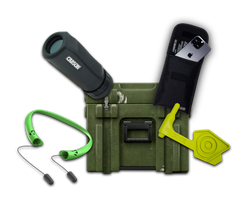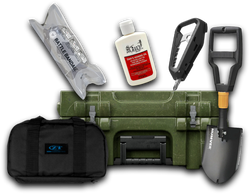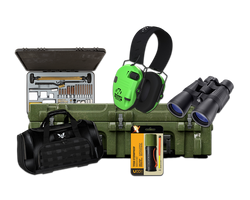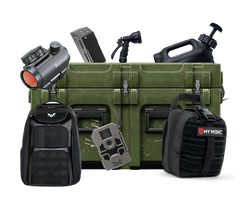How to Fix a Carabiner: A Comprehensive Guide for Tactical Enthusiasts
Table of Contents
- Introduction
- Understanding Carabiner Types and Their Uses
- Common Problems with Carabiners
- Step-by-Step Instructions on How to Fix a Carabiner
- Maintenance Tips to Prolong the Life of Your Carabiner
- When to Replace a Carabiner
- Conclusion
- FAQ Section
Introduction
Imagine you're out in the wilderness, ready to tackle a climbing route or secure gear on your pack, only to find that your trusty carabiner won't snap back into place. A broken or malfunctioning carabiner can turn a reliable tool into a frustrating obstacle. While many might think their only option is to toss it and buy a new one, there are effective ways to fix a carabiner, saving money and keeping you prepared for your next adventure.
Carabiners are essential tools used in a variety of outdoor activities, from climbing and camping to securing gear in tactical situations. Their design, while straightforward, can sometimes lead to common issues like misaligned gates or broken springs. This article aims to provide you with a thorough understanding of how to fix a carabiner and maintain its functionality, specifically focusing on lightweight designs often used in everyday scenarios.
By the end of this guide, you'll not only know how to fix a carabiner but also understand when it’s time to replace it, ensuring your safety and preparedness remain uncompromised. We will cover:
- Understanding carabiner types and their uses
- Common problems that occur with carabiners
- Step-by-step instructions on how to fix specific issues
- Maintenance tips to prolong the life of your carabiner
- When it's best to replace a carabiner
Let’s dive into the world of carabiner repairs and empower you with the knowledge to keep your gear in top shape.
Understanding Carabiner Types and Their Uses
1. The Basics of Carabiners
Carabiners are metal loops with a spring-loaded gate, primarily used to connect components in climbing, caving, rope rescue, and other outdoor activities. They come in various shapes and sizes, each suited for different tasks:
- Lightweight Carabiners: Ideal for everyday use, these are often used for securing gear without the heavy load-bearing requirements.
- Climbing Carabiners: These are rated for specific loads and are designed to withstand the forces encountered during climbing; they usually feature a lock mechanism for added safety.
- Specialized Carabiners: Designed for specific applications, these can include locking mechanisms, wider gates, or unique shapes for niche uses.
2. Common Uses for Carabiners
- Climbing: To attach climbing gear, harnesses, and ropes.
- Camping: To secure tents, tarps, and gear.
- Tactical Applications: For attaching equipment to packs, belts, or other gear in tactical scenarios.
- Everyday Carry (EDC): Used to hold keys or lightweight tools.
Understanding these distinctions is crucial, as it influences the approach to repairs and the decision to fix or replace a carabiner.
Common Problems with Carabiners
1. Misaligned Gates
One of the most frequent issues with carabiners is a misaligned gate. This can occur from improper use or stress on the hinge, causing the gate to not close properly.
2. Broken Springs
The spring inside the gate can dislodge or break, leading to a carabiner that won’t close securely. This is often misinterpreted as a complete failure of the carabiner.
3. Dirt and Debris
Over time, dirt and debris can accumulate in the pivot point, making the gate sticky or difficult to operate. Regular cleaning can help prevent this issue.
4. Bent or Damaged Gates
If a carabiner is subjected to excessive force, the gate may bend or warp, preventing it from functioning correctly.
Understanding these common problems allows you to identify the right solutions quickly.
Step-by-Step Instructions on How to Fix a Carabiner
Fixing a Misaligned Gate
- Inspect the Carabiner: Examine the carabiner for any visible damage or misalignment.
- Use Pliers: If the gate is slightly misaligned, use needle nose pliers to gently adjust the gate back into position.
- Test the Gate: Open and close the gate several times to ensure it operates smoothly.
Repairing a Broken Spring
If the spring has come out of its slot:
- Gather Tools: You will need a standard screwdriver and possibly pliers.
- Reinsert the Spring: Look for where the spring has come loose and gently push it back into its original position.
- Test the Gate: Ensure the gate snaps back into place securely.
Note: If the spring is broken and cannot be reinserted, you may need to replace the carabiner.
Cleaning a Sticky Carabiner
- Disassemble if Possible: If your carabiner allows for it, disassemble it to access the pivot point.
- Wash with Soapy Water: Clean the carabiner in warm, soapy water to remove dirt.
- Lubricate: Once dry, apply a small amount of lubricant designed for metal to the pivot point to ensure smooth operation.
Fixing a Bent Gate
- Assess the Damage: Determine how much the gate is bent.
- Bend Back Gently: Using your hands or pliers, carefully bend the gate back into its original shape.
- Test for Functionality: Open and close the gate to ensure it operates correctly.
Maintenance Tips to Prolong the Life of Your Carabiner
1. Regular Cleaning
Make it a habit to clean your carabiners after each use, especially if they have been exposed to dirt, saltwater, or other corrosive elements. A simple wash with soap and water can significantly extend their life.
2. Inspect Before Use
Always inspect your gear before each use. Look for signs of wear, such as cracks, bends, or sticking gates.
3. Proper Storage
Store your carabiners in a cool, dry place away from direct sunlight and moisture to prevent corrosion and degradation.
4. Avoid Overloading
Understand the weight limits of your carabiners. Exceeding these limits can lead to failure and compromise your safety.
When to Replace a Carabiner
Despite your best efforts to maintain and repair your carabiner, there are times when replacement is the safest option:
- Structural Damage: If there are any signs of deformation, cracks, or severe wear, it's best to replace the carabiner rather than risk failure.
- Repeated Repairs: If you find yourself frequently needing to fix the same issue, the integrity of the carabiner may be compromised.
- Use in Safety Applications: If the carabiner is used for climbing or other safety-critical applications, any failure should lead to immediate replacement.
Conclusion
Knowing how to fix a carabiner is an essential skill for anyone who relies on these versatile tools in their outdoor or tactical activities. By understanding the common issues that can arise and having the skills to address them, you can ensure your gear remains reliable.
Remember to maintain your carabiners through regular cleaning and inspection. While minor repairs can extend the life of your carabiner, knowing when to replace it is equally important for your safety and preparedness.
To equip yourself with high-quality carabiners and other tactical gear, consider exploring Crate Club's subscription services. Each month, receive curated gear that empowers you to tackle any challenge.
- Check out the Crate Club Subscription Services for different tiers tailored to your needs.
- For immediate purchases, visit the Crate Club Shop for a selection of top-notch tactical gear.
FAQ Section
Q: Can I fix a climbing carabiner?
A: It’s generally not recommended to fix a climbing carabiner after it has sustained damage, as its integrity is crucial for safety. If a climbing carabiner shows any signs of failure, it should be replaced immediately.
Q: How can I tell if my carabiner is beyond repair?
A: If there are any cracks, severe bends, or if it fails to function correctly even after repairs, it’s time to replace the carabiner.
Q: What kind of lubricant should I use on my carabiner?
A: Use a lubricant designed for metal applications, such as silicone-based or a dedicated gear lubricant, to ensure smooth operation without attracting dirt.
Q: Is it safe to use a carabiner that has been repaired?
A: If you have repaired a lightweight carabiner and it operates smoothly, it may be safe for non-critical uses. However, always err on the side of caution and replace it if it was previously used in safety applications.
Q: How often should I replace my carabiner?
A: Regular use carabiners should be replaced every few years or sooner if they show signs of wear. For climbing and safety applications, inspect them before each use and replace them at the first sign of damage.
By understanding how to fix and maintain your carabiners, you can ensure that you are always prepared for your next adventure—adding tactical readiness to your outdoor experiences.
Share this article



